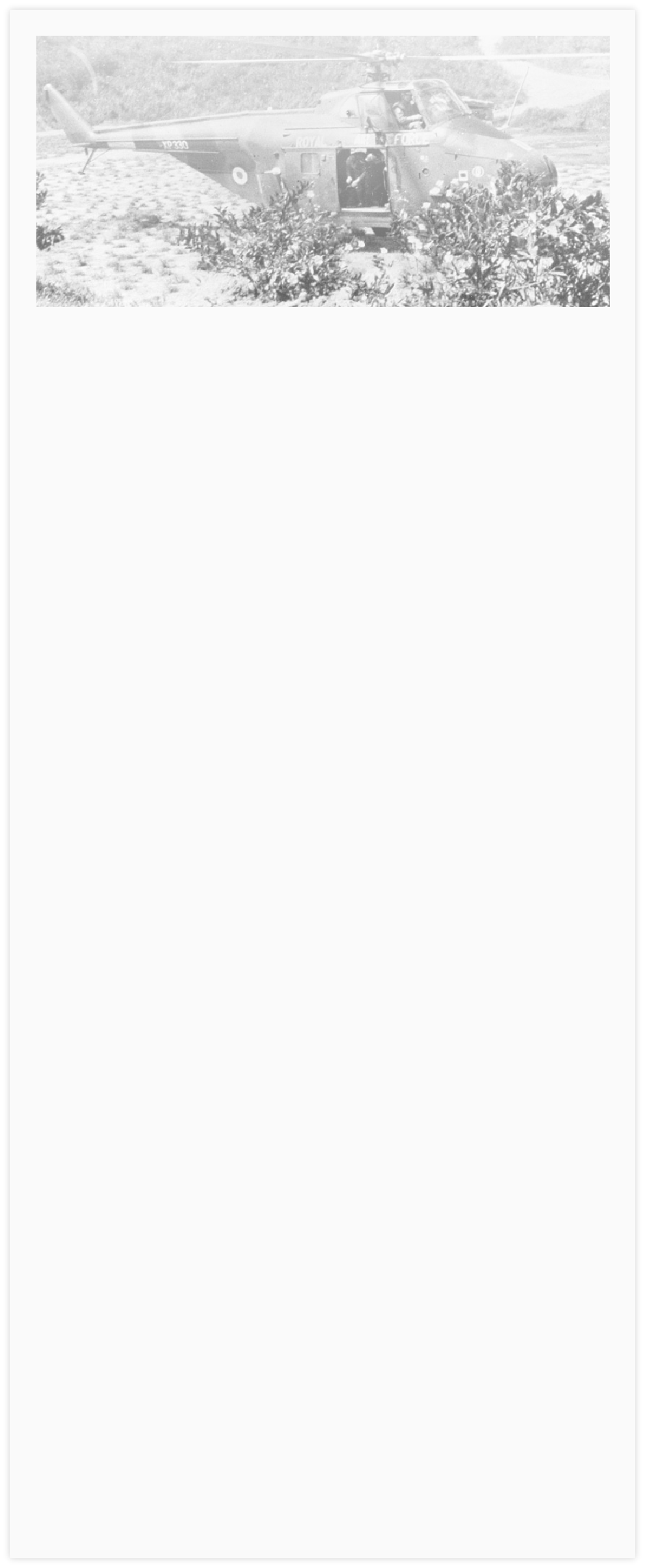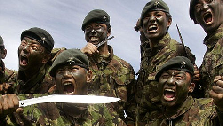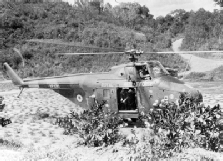General Walter arrived in Borneo in December 1962 to find a country with few motorable roads outside the urban areas and no railways. There was only one deep-sea port at Labuan. Initially there were no stockpiles of military supplies. They would have to be brought over 900 miles from Singapore by sea and air. There were no camps for the troops, no generators, no pumping engines, no workshops and no local military forces from which to obtain advice or assistance. General Walker's first task was therefore to build up the military infrastructure to support enough forces to face the Indonesian forces. In December 1962, Walker had only one infantry brigade of three battalions, six naval coastal minesweepers and some fifteen naval and air force helicopters.
At first, the task of defending Malaysia was seemingly insurmountable, as half of the federation was hundreds of miles away, making redeployment and reinforcement more difficult than usual. The 900-mile land border with Indonesian Borneo is covered in dense rain forest. All the Malay Peninsula can be reached by canoe form Sumatra. The island of Borneo is set at the very centre of the Indonesian Archipelago and forms the southern limits of the South China Sea. It is about 7850 miles long and 600 miles across its greatest width. The equator cuts across the centre of the island making the climate inhospitable in the extreme. Vast mountain ranges dominate the island interspersed with valleys and plateaus all of which are covered by tropical rain forest. The jungle is as bad as anything that British troops faced in Malaya or Burma. The 100-foot trees cast a deep green gloom. The streams are infested with leeches, and the hillsides are sometimes vertical. A pair of canvas jungle boots rots after two weeks. In the lowland swamps, the nights are nearly as hot as the days, while elsewhere in the highlands the night air is so cold that men shiver in their jungle-green uniforms even inside a sleeping bag.
Indonesian raidersThe first attack came on 28th September 1963 when about 200 Indonesian raiders crossed the mountains into the jungles of the Third Division and launched an attack on the small outpost at Long Jawai. The garrison consisted of six Ghurkhas, three policemen and twenty-one border scouts, but despite a spirited defence Long Jawai fell. The Indonesians' had penetrated fifty miles into Borneo, and that was their mistake. They had to get back to the border on foot. The Wessex Helicopters of No.845 Squadron Fleet Air Arm flew platoons of the 1/2nd Ghurkha Rifles into ambush positions along the intruders' likely line of retreat. A large proportion of the Indonesian force was destroyed in several actions over the next twelve days including twenty-six Indonesians who were killed instantly when their two longboats were expertly ambushed by a platoon of Ghurkhas in position on the riverbank.
The second attack was in the last three days of 1963, when a large force of raiders attacked the village of 'Kalabakan, thirty miles west of Tawau. The half-company of the 3rd Royal Malay Regiment there was surprised, and called in the Ghurkhas. Walker deployed the Ghurkhas in a similar manner as he had after Long Jawai and within a month only six of the raiding force had not been killed or captured by the security forces.
105s in action. In January 1964, Sukarno called a temporary ceasefire to give himself some breathing room, but fighting resumed in March. The Indonesian conflict broadened as the Indonesian Army's regular units began to get involved instead of just supplying advisors to the insurgents. The 2/10th Ghurkhas were the first to clash with a unit of the Indonesian regular army on 7th March. After a sharp fight the Indonesians' withdrew from their positions, and moved into a new position some sixteen miles along the ridge they had originally occupied. They were attacked by anti-tank missiles from two Wessex helicopters, a troop of 105mm light guns and two Saladin Armoured cars, but even with this support the Ghurkhas had a hard fight to dislodge the Indonesians. The same pattern continued until September as Indonesian forces established more bases on the border and the fighting got worse. Walker persuaded the Government to authorize cross -border attacks against Indonesian bases within artillery range, about 18,000 yards that had been shelling locations across the border.
January 1965 saw the British troops in Borneo rearmed, with newer rifles, a more effective mortar and the American Claymore Mine. Seismic detectors completed the rearmament and allowed British bases to monitor a significant length of border. Throughout 1965 the network of platoon and company-sized forts were strengthened and improved as the undeclared war continued. The forts were usually built on high ground and surrounded by a perimeter of barbed wire and 'punjis', sturdy fire-hardened bamboo sticks sharpened at both ends and driven into the ground at the appropriate angle so as to present a would-be attacker with an array of needle-sharp bamboos at thigh height upon which it was hoped he would impale himself. A trench and bunker system allowed the defenders to man the perimeter in comparative safety. The ground was cleared out for about a hundred yards from the perimeter to create effective fields of fire. Each base had fire support units of 81mm mortars or 105mm howitzers with Claymores sited around the perimeter.
Patrols operated on a six-mouth tour, with only several weeks rest and recuperation behind the lines during that tour. Ten to twelve day patrols were the normal, followed by three or four days as guard for the base before the next patrol, enough time to re-equip, shave, clean up and rest before going out again. Letters and parcels were dropped by helicopter or parachute and replies were written lovingly and laboriously into the night.
Patrolling in Borneo was a strain. Encounters with the enemy were always a possibility, though when it happened it was usually unplanned, unexpected and fleeting in nature. Whether the instigator or the victim of an ambush, contact with the enemy was often over in seconds. The ability to shoot quickly and accurately was paramount. The patrol commander always faced the dilemma of walking a trail and perhaps running into an ambush or treading on an anti-personnel mine or hacking his way through nearly impossible secondary jungle at the rate of perhaps 200 yards an hour. It was a game of cat and mouse, of hide and seek and sometimes even of bluff and counter-bluff. At five o'clock it began to get dark, and the patrols broke off the track and established a bivouac area for the night, as movement in the jungle without light being impracticable. A circular perimeter was established, sentries posted, and a cold evening meal quietly eaten. For most of the Borneo campaign it was considered unsafe to cook in the jungle.
Patrol BoatWhen Walker handed over command in March 1965, he left behind a multi-national force in Borneo of some 18,000 men of which over half were British and the remainder were Ghurkha, Malay, Australian and New Zealanders. There were some 1,500 border scouts recruited from the indigenous tribes - Dyak, Sea Dyak, Kenyan, Keyan and half a dozen others. In addition there was a considerable naval presence of coastal minesweepers and fast patrols boats, some eighty helicopters and about forty fixed-wing aircraft which included delta-wing Javelin fighters. Walker's force also included a composite regiment of the Special Air Service regiment, the squadrons being British, Australian and New Zealand, and two regiments each of armoured cars, engineers and artillery.
Gurkha Rifles Border clashes between British and Commonwealth troops and Indonesian units continued throughout 1965. It was on one of General Lea's cross border operations that Lance Corporal Rambahadur Limbu of the 2/10th Ghurkha Rifles won the Victoria Cross, in the border area of the First Division near Bau. 1965 also saw the Indonesian raiders introduce simple wooden 'cigar-box' anti-personnel mines along border tracks. This added a macabre and sickly note into patrolling and a number of legs and feet were lost. In his attempt to gain assistance from China, Sukarno had flirted with the Communist Party and this had seriously undermined his position and he was reduced to the status of a puppet president when General Suharto took over effective leadership of the nation in March 1966. Peace feelers were put out and culminated in a peace agreement signed in Jakarta on 11th August 1966.
Fighting had continued in small skirmishes right up until the agreement was signed.
Gurkhas board heloIn the fighting, the eight Ghurkha battalions had suffered 43 killed and 87 wounded, the Royal Marine Commandos 16 killed and 20 wounded and the British battalions 16 killed and 51 wounded. Officially Indonesian casualties were put at 600 killed but it is certain that they were considerably greater as a result of the British cross border operations. The campaign was a victory for the British and Malaysian forces, and the Minister of Defence at that time, Mr. Denis Healy declared in the House of Commons that the Borneo Campaign would be recorded 'in the history books ...as one of the most efficient uses of military force in the history of the world.










